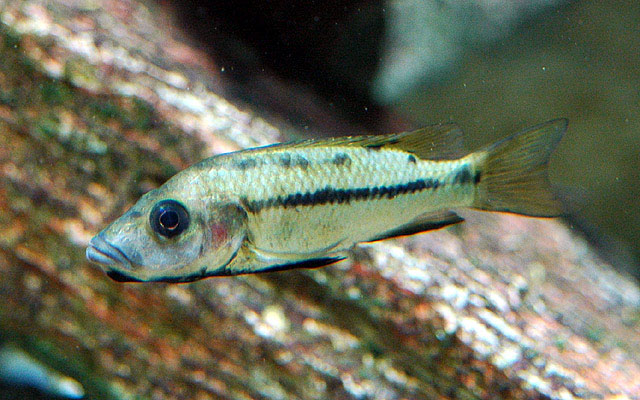| Cichlidae (Cichlids), subfamily: Pseudocrenilabrinae |
| 12 cm SL (male/unsexed) |
|
benthopelagic; freshwater, |
| Africa: endemic to Lake Barombi-Mbo, Cameroon (Ref. 52307, 81260). |
|
Dorsal spines (total): 14-15; Dorsal soft rays (total): 10-12; Anal spines: 3-3; Anal soft rays: 9-10. Diagnosis: relatively robust, body depth 29.5-35.4% of standard length; mouth large, upper jaw (28.5-35.2% HL); lateral line system on head not notably enlarged; coloration dominated by a continuous mid-lateral band running from opercle to mid-level of caudal peduncle; microbranchiospines present on outer faces of second through fourth gill arches (Ref. 81260).
Description: snout 30.5-40.0% HL; preorbital depth 18.5-24.0% HL; outer teeth in oral jaws with 2 unequal cusps or minor cusp reduced to a shoulder or absent; inner row teeth tricuspid at all sizes; lower pharyngeal jaw slightly longer than wide, teeth small and hooked; gill rakers small, conical; ; microbranchiospines present; lateral line system on head not enlarged or inflated (Ref. 81260).
Coloration: base body coloration silvery grey with some brassy iridescence (Ref. 81260). Continuous, dark grey-black mid-lateral band present from opercle to mid-level of caudal peduncle (Ref. 52307, 81260). Often a dark spot at caudal base; dorsal, caudal and pectoral fins watery yellow, orange-yellow in mature males; pelvic and anal fins dusky grey; large "tilapia spot" present in soft dorsal fin of juveniles, this spot fades with age but a trace may be retained in adults (Ref. 81260). |
| Seems to prefer the more open regions of the lake; vagabonding, fast-swimming species; ovophilic, maternal mouthbrooder (Ref. 52307). Predatory; reported to kleptoparasitize the freshwater crab Potamon africanus (Ref. 81260). Prefers small fish, shrimp and insect larvae (Ref. 52307). Aquarium conditions: pH=9, H=25, 30°C water temperature, omnivore, egg layer, needs rocky cover and substratum, not easy to raise in tanks (Ref. 6398). |
|
Critically Endangered (CR); Date assessed: 16 February 2009 (B1ab(iii)+2ab(iii)) Ref. (130435)
|
| harmless |
Source and more info: www.fishbase.org. For personal, classroom, and other internal use only. Not for publication.
